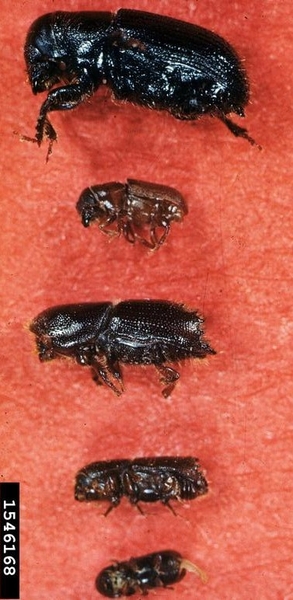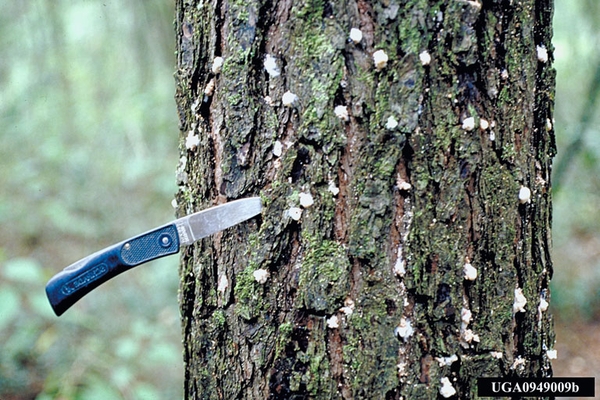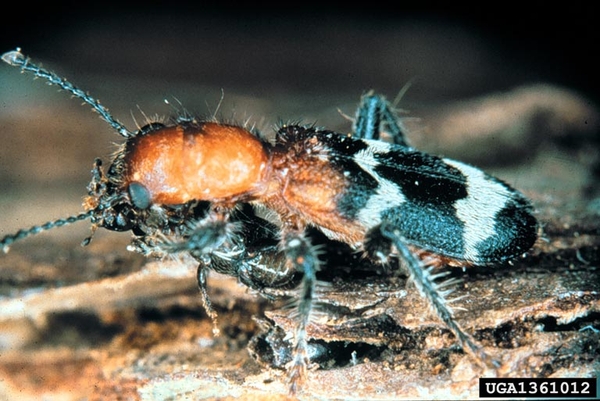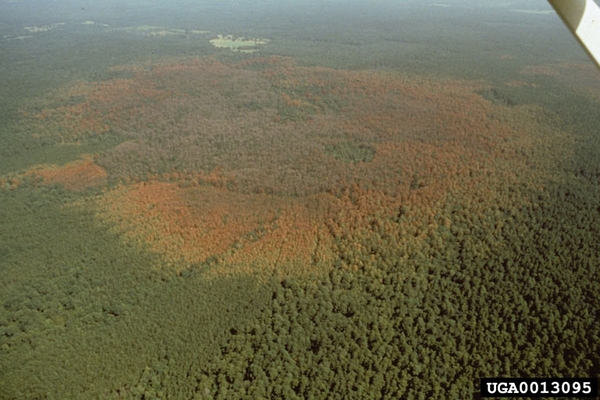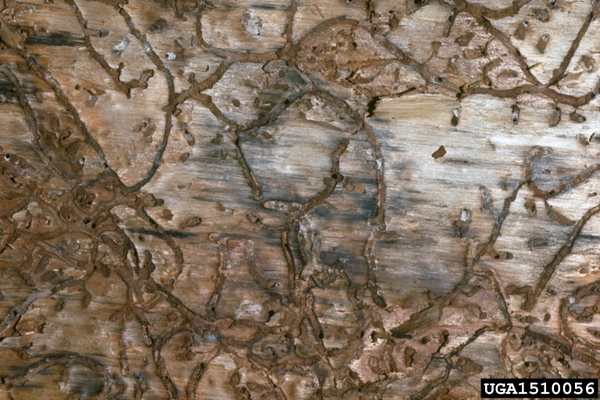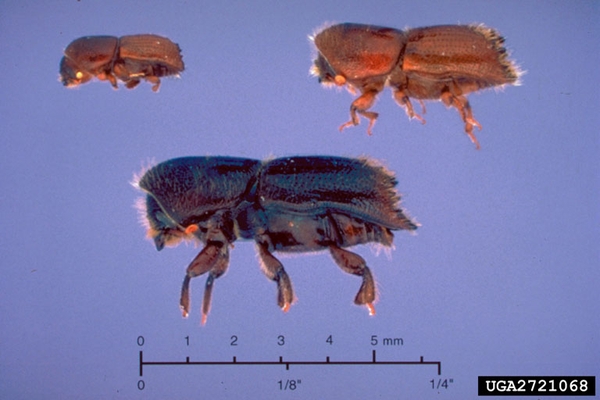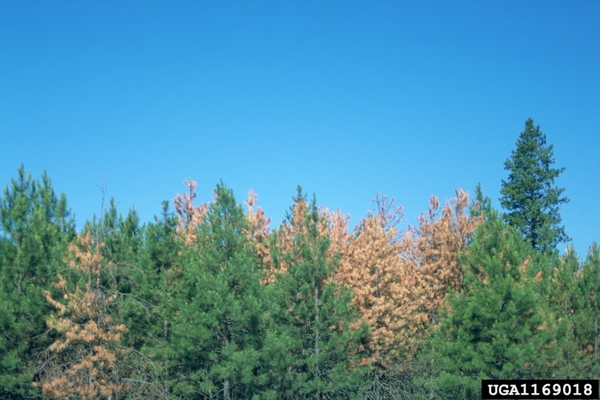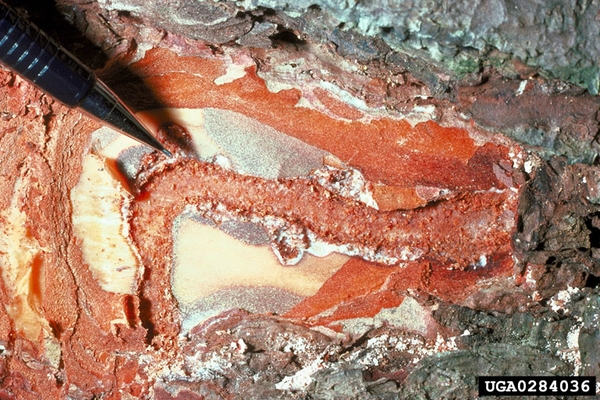Introduction
Several species of bark beetles attack southern pines (Pinus spp.) and are generally referred to in three groups: the southern pine beetle, three species of Ips engraver beetles (often referred to simply as "Ips"), and the black turpentine beetle (Figure 1). These beetles primarily attack pines stressed by another agent (e.g., drought, disease). However, in some cases, outbreaks of the southern pine beetle and occasionally, Ips engraver beetles, can occur.
All species of pine bark beetles feed on the inner bark of pine trees, girdling the nutrient-conducting tissues just beneath the bark. Removal of this tissue causes bark to slough off during and after heavy infestations. As bark beetles feed, they tunnel beneath the bark, creating galleries. These galleries, if viewed before other organisms (e.g., termites) colonize the dead or dying tree, can be diagnostic of the insect who created it.
During a bark beetle attack, pine needles fade from green to light green, to yellow, to red (Figure 2). These "red-topped" trees stand out amongst an otherwise green forest and are looked for during aerial survey for forest pests (Figure 3).
When bark beetles enter a tree, the tree may defend itself by extruding sap. This sap dries, forming "pitch tubes" (Figure 4). Pitch tubes are a good sign that bark beetles are attacking a tree, but they may not tell you which species. Moreover, stressed trees may not have the resources available to produce sap, so pitch tubes are not always present.
Proper forest management is critical in keeping infestations of pine bark beetles low, but when they do strike, it is important to be able to distinguish between them so that the appropriate management is implemented. This fact sheet discusses the three most common pine bark beetles in North Carolina and their impacts, identification, and management.
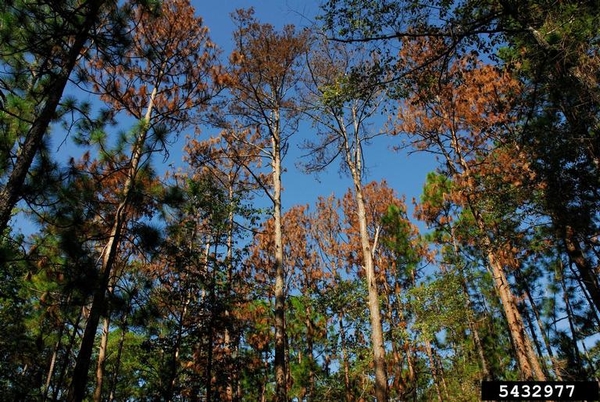
Figure 2. Pines killed by bark beetles fade from green, to yellow, to red. Here, southern pine beetle and Ips engraver beetles infest a pine stand. These red-topped trees are often the first-noticed indication of a bark beetle infestation.
Erich G. Vallery, USDA Forest Service - SRS-4552, Bugwood.org
Southern Pine Beetle
Considered "the worst pest of southern forests," the southern pine beetle (SPB; Dendroctonus frontalis) has the potential to cause major destruction during outbreaks (Figure 5). Most years, SPB behaves as a secondary pest, attacking already-stressed trees. However, cyclical outbreaks can result in widespread pine mortality and significant economic losses. From 1960 through 1990, SPB caused an estimated $900 million of damage (Price et al. 1992). An outbreak is defined as "one or more multiple-tree southern pine beetle infestations per 1000 acres of susceptible host type" (Clark and Nowak 2009).
Because of its potential to cause significant loss, SPB is heavily monitored. Each spring, SPB traps are set across the state to predict the SPB population trends for the upcoming growing season. These results are based primarily on the ratio between SPB and its primary predator, the checkered beetle (clerid beetle) (Figure 6). Trapping results are shared so land managers can make management decisions which may include increased surveillance throughout the season. In addition, aerial surveys are conducted annually by the N.C. Forest Service to detect forest disturbances, with special attention given to looking for SPB spots (Figure 7). If spots are detected, they can be managed more quickly, and damages can be reduced.
SPB spot management consists of cutting down trees with an active infestation in addition to a buffer of green trees. Trees can be removed (cut-and-remove) or left on site (cut-and-leave). Cut-and-remove is not only the most effective option at 97% efficacy, but landowners may benefit from the sale of harvested trees.
Ips Engraver Beetles
Ips engraver beetles are a group of species belonging to the same genus, Ips (Figure 9). They are often referred to simply as "Ips" or pine engraver beetles. Ips engraver beetles are secondary pests, attacking already-stressed trees. Common stress agents that predispose trees to Ips engraver beetle attack include drought, overstocked or poor stand conditions, storm or fire damage, and lightning strikes. In some cases, Ips engraver beetles may attack small groups of seemingly-healthy trees but populations typically do not become widespread as they do with southern pine beetle. Usually, when the stressing agent subsides (e.g., drought ends), infestations also subside.
Because they primarily attack stressed or damaged trees, Ips engraver beetle infestations usually occur in scattered trees within a stand (Figure 10). Their galleries beneath the bark are I-, Y-, X-, or H-shaped (Figure 11). They can attack any portion of the tree, and therefore pitch tubes and beetle presence can occur in the canopy, out of reach and view from observers. Management is seldom warranted for Ips engraver beetle infestations, but land managers may remove heavily infested trees to reduce populations and risk to nearby trees.
Black Turpentine Beetle
The black turpentine beetle (BTB; D. terebrans) (Figure 12) is considered a secondary forest pest, attacking already-stressed trees. It is the largest of the bark beetles of southern pines and attacks the largest portion of the tree: the lower 15 feet of the main stem or trunk (Figure 13). All southern pine species are susceptible.
Infestation occurs most frequently in recently wounded trees (e.g., injured by logging equipment, storm damage, fire) or in overstocked stands. Light infestations cause localized inner bark death and the tree may survive, but in high infestations, trees are killed and BTB populations may spill over into nearby seemingly-healthy trees. Despite this, population outbreaks do not continue expanding in the same manner as southern pine beetle spots. Management is seldom warranted for BTB infestations, but land managers may remove heavily infested trees to reduce populations and risk to nearby trees.

Figure 13. Black turpentine beetle attacks often results in large pitch tubes on the lower 15 ft. on the trunk.
Kelly Oten, NC State University CC BY 4.0
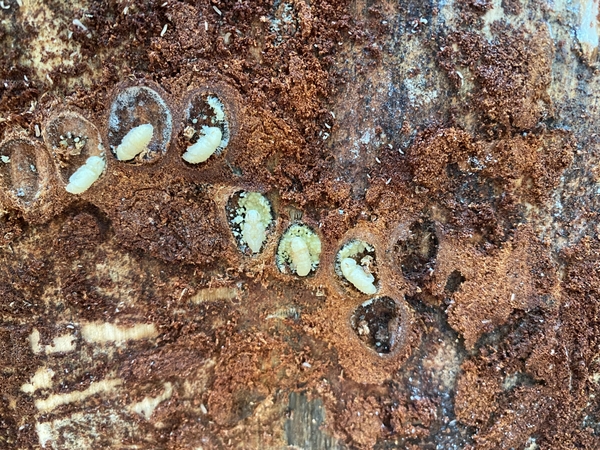
Figure 15. Black turpentine larvae and pupae (shown) can be found under pine bark during an active infestation.
Kelly Oten, NC State University CC BY 4.0
Distinguishing Between Bark Beetles of Southern Pines
Given the potential difference in infestation severity and a land manager's management options, it is important to be able to distinguish bark beetles from one another.
| Southern Pine Beetle | Ips Engraver Beetles | Black Turpentine Beetle | |
|---|---|---|---|
| Galleries | S-shaped | I, X, Y, or H-shaped | meandering, wide, frass-filled, lower 15 ft. of main stem/trunk |
| Discolored Needles | whole tree | may be individual branches/tops or whole tree | whole tree |
| Location of Pitch Tubes | in bark crevices | often on bark plates | large, basal 15 ft. of main stem/trunk |
| Stand-level Infestation Pattern | spot (adjacent trees) | scattered trees | scattered trees |
| Prevention | thin overstocked stands | thin overstocked stands | thin overstocked stands; avoid injury (e.g., logging scars); monitor for BTB activity |
| Management | salvage (cut-and-remove) or cut-and-leave; remove infested trees plus a buffer | seldom warranted; remove dead and dying trees | seldom warranted; remove infested trees to prevent population build-up |
Southern Pine Beetle Prevention Program
Thinning overstocked pine stands is the best way to prevent a pine bark beetle outbreak. The N.C. Forest Service administers the Southern Pine Beetle Prevention Program, a state-operated cost-share program sponsored by the U.S. Forest Service. Eligible stands must have 700+ stems per acre and be at least 70% pine. Pre-commercial thinning reduces the density to 300-450 stems per acre, reducing competition between trees and drastically improving their ability to withstand attack to bark beetles. (White pine stands with a basal area greater than 150 ft2 are eligible and will be reduced to 90 ft2 basal area or less.) Some years, other management options (e.g., prescribed burning, mid-rotation herbicide application) are also eligible for cost-share. Funds are available to non-industrial private landowners. Visit the N.C. Forest Service's Southern Pine Beetle Prevention Program website or contact your county ranger for current information.
Additional Resources
N.C. Forest Service - Southern Pine Beetle Prevention Program
Southern Pine Beetle Prediction Trapping Results
North Carolina Drought Monitor
Clarke, S. and J. Nowak. 2009. Southern Pine Beetle. Forest Insect & Disease Leaflet 49. U.S. Department of Agriculture Forest Service.
Price, T.S., C. Doggett, J.L. Pye, and T.P. Holmes, eds. 1992. A history of southern pine beetle outbreaks in the southeastern United States. Sponsored by the Southern Forest Insect Work Conference. The Georgia Forestry Commission, Macon, GA. 65 p.
Publication date: Aug. 4, 2022
N.C. Cooperative Extension prohibits discrimination and harassment regardless of age, color, disability, family and marital status, gender identity, national origin, political beliefs, race, religion, sex (including pregnancy), sexual orientation and veteran status.

